
(Williams, p. 53)
Queen Catherine wears the gable headdress with lappets turned up. Note the length of the front jewelled portion. In its early form this extended below the chin. In later years it was at chin length or higher. Note also that the black drape in the back hangs down. In later hoods one or both "tails" were turned up and pinned to the top of the bonnet.

(Williams, p. 203)
Includes a rare view of the back of this headdress which raises some interesting questions: the back appears to contain structural elements, that is, it appears to be a stiffened box. The veil does not appear to be cast over the back of the headdress, but affixed or sewn to it in some way.

(Batschmann, p. 167)
This preliminary sketch for the formal portrait, below, shows Lady Guildford in a less stylized manner.
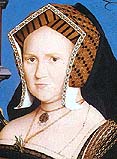
(Langdon, p. 72)
In this case, the over lappet does not show its lining. Also the peak at the back of the hat suggests that the back as well as the front, contained stiffened elements.
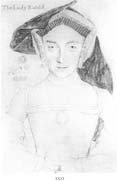
(Dvorák,, pl. 26)

(Rowlands, p. 75)

(Hearn, p. 146)
"Elizabeth, second daughter of Sir Thomas More, born 1506; married William, son of Sir John Dauncey, Knight of the Body to Henry VIII, 1525. The Lady Berkeley, wrongly named in the inscription, was Sir John Savage's daughter who, in 1533, married Thomas, Lord Berkeley, and died in I564, aged 58. The two ladies were therefore the same age, which may to some extent explain the confusion between them." (Parker, p. 36)

(Rupp, Plate 45)
As this is a copy of the lost Holbein painting, the details may not be trustworthy. Nevertheless, the geometric pattern of the overlappets, and general color scheme of browns/black, is similar to the other examples.
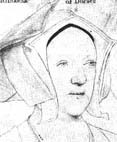
(Starkey, p. 103)
Elizabeth I's godmother, the sketch was proabably done at the time of her christening.

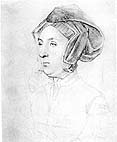


(Langdon, pl. 34)
"The starchy headdress Lady Eliot wears seems to have been of a design baffling even to Holbein (he had had trouble depicting Lady Guildford's in 1527), probably because of the way in which it prevents that definition of the back of the head which allows the face to jut into the picture space convincingly." (Langdon)

The preliminary sketch for the famous painting, below.
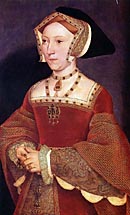
(Langdon, p. 90)

(Parker, pl. 18)

(Parker, pl. 20)
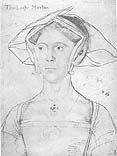
(Parker, pl. 21)
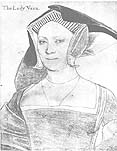
(Parker, pl. 25)

(Parker, pl. 27)
Parker states that the original drawing has been retouched, particularly in the veil area.
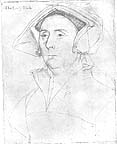
(Parker, pl. 55)

(Parker, pl. 67)